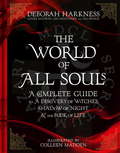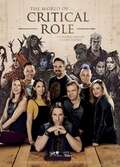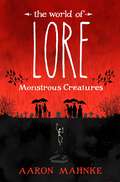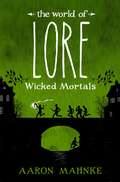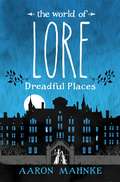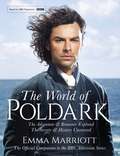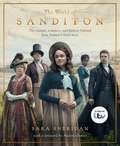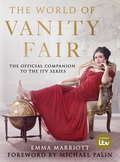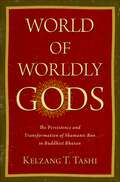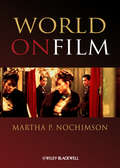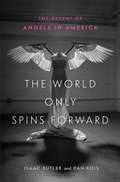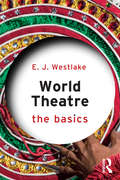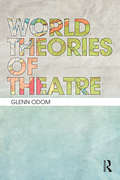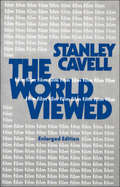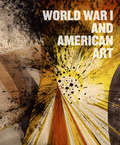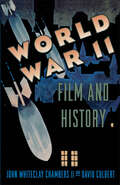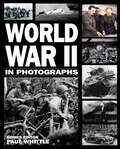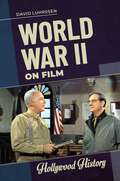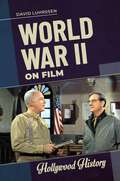- Table View
- List View
The World of All Souls: A Complete Guide to A Discovery of Witches, Shadow of Night and The Book of Life (All Souls Trilogy Ser.)
by Deborah HarknessDiscover the truths, the history, the myths and the magic behind the bestselling All Souls trilogy. Fall under the spell once more with this all-encompassing insider's guide to A Discovery of Witches, Shadow of Night and The Book of Life. The All Souls trilogy by Deborah Harkness, featuring historian and witch Diana Bishop and vampire scientist Matthew Clairmont, delves into mythology, alchemy, literature and architecture. And history is brought to life. With her signature historian's touch, Deborah Harkness offers an encyclopaedic look at the series, complete with synopses, character biographies, maps, recipes, and even the science behind creatures, magic and alchemy. Bursting with fascinating facts and original artwork, The World of All Souls is the ultimate companion for fans of the All Souls trilogy and unlocks this fantastical world, letting you in on all its secrets and mysteries. Praise for the All Souls trilogy: 'This is a glorious, finely-wrought gem of a book: intelligent, thoughtful, intricate. . . Utterly enchanting on every level' Manda Scott on A DISCOVERY OF WITCHES 'Deborah Harkness writes as if she's the hugely more talented love child of Diana Gabaldon and J. K. Rowling' thebookbag.co.uk on SHADOW OF NIGHT 'Rich in arcane detail, fans will relish this exotic cauldron of romantic fantasy' Sunday Mirror on THE BOOK OF LIFE
The World of Critical Role: The History Behind the Epic Fantasy (Critical Role Ser.)
by Liz Marsham Cast of Critical RoleDive deep into the history of the world's most popular fantasy RPG livestream with the cast of Critical Role in this definitive guide featuring never-before-seen illustrations and photos.From its unassuming beginnings as a casual home game between friends to the role-playing phenomenon it is today, Critical Role has become the stuff of legend. These pages chronicle how a circle of friends who all happen to be talented voice actors built the most-watched tabletop role-playing livestream of all time.Discover dazzling new illustrations and richly written insights into the locations, characters, and adventures featured in the hundreds of episodes across Critical Role's two campaigns, Vox Machina and the Mighty Nein. Go behind the scenes with archival photos and exclusive interviews with Dungeon Master Matt Mercer and the entire Critical Role cast as they explore their characters' most triumphant moments and darkest hours. And celebrate the massive community of Critters who support and expand the show's world through a highlighted tour of the crafts, cosplay, and art they create every day.Featuring a foreword from the cast, lush illustrations, and the inside story you won't find anywhere else, this book is your indispensable guide to Critical Role.The adventure begins!
The World of Lore, Volume 1: Now a major online streaming series (The World of Lore #1)
by Aaron MahnkeA fascinating, beautifully illustrated collection of stories from the hit podcast Lore - now an online streaming series They live in shadows - deep in the forest, late in the night, in the dark recesses of our mind. They're spoken of in stories and superstitions, relics of an unenlightened age, old wives' tales, passed down through generations. And yet, no matter how wary and jaded we have become, as individuals or as a society, a part of us remains vulnerable to them. Werewolves and wendigos, poltergeists and vampires, angry elves and vengeful spirits.In this beautifully illustrated volume, the host of the hit podcast Lore serves as a guide on a fascinating journey through the history of these terrifying creatures, and explores not only the legends but what they tell us about ourselves. Aaron Mahnke invites us to the desolate Pine Barrens of New Jersey, where the notorious winged, red-eyed Jersey Devil dwells. Mahnke delves into harrowing accounts of cannibalism-some officially documented, others the stuff of speculation . . . perhaps. He visits the dimly lit rooms where séances take place, the European villages where gremlins make mischief, and Key West, Florida, home of a haunted doll named Robert.The monsters of folklore have become not only a part of our language but a part of our collective psyche. Whether these beasts and bogeymen are real or just a reflection of our primal fears, we know, on some level, that not every mystery has been explained, and that the unknown still holds the power to strike fear deep in our hearts and souls. As Aaron Mahnke reminds us, sometimes the truth is even scarier than the lore...Praise for the Lore podcast'Truth can often be much scarier than fiction - something Mahnke proves as he dives deep into the world of folklore and the darker side of history in a quest to root out the fragment of truth at the bottom of our fears." - Entertainment Weekly'Narrated by Mahnke in a style that evokes spooky campfire stories, Lore is a history lesson like no other.' - Esquire
The World of Lore, Volume 2: Now a major online streaming series (The World of Lore #2)
by Aaron MahnkeA chilling, lavishly illustrated who's-who of the most despicable people ever to walk the earth, featuring both rare and best-loved stories from the hit podcast Lore, now an online streaming series. Here are the incredible true stories of some of the mortals who achieved notoriety in history and folklore through horrible means. Monsters of this sort - serial killers, desperate criminals, and socially mobile people with a much darker double-life - are, in fact, quite real . . . including H. H. Holmes, the infamous Chicago serial killer; William Brodie, the Edinburgh criminal mastermind who inspired The Strange Case of Dr. Jekyll and Mr. Hyde; and Bela Kiss, a Hungarian tinsmith with a most disturbing hobby: collecting women in gasoline drums. As Aaron Mahnke reminds us, sometimes the truth is even more frightening than the lore.
The World of Lore, Volume 3: Now a major online streaming series (The World of Lore #3)
by Aaron MahnkeFor fans of Neil Gaiman and Welcome to Night Vale, Aaron Mahnke's The World of Lore (based on the hit LORE podcast) explores the chilling truth behind the legendary creatures, peculiar people and horrific places that arouse our deepest fears. Now on online streaming seriesVolume 3: Dreadful PlacesThis third book in The World of Lore series will explore dark and dreadful places on land and at sea, places haunted by tragedy and filled with echoes of evil. These are the stories about cities, and buildings, too, from New Orleans to Louisiana and Richmond, Virginia, as well as infamous places like the Stanley Hotel in Colorado and England's most frightening and brooding castles...
The World of Poldark
by Emma MarriottEmma Marriott's The World of Poldark explores the characters, the compelling stories and the era that Winston Graham - and the television series - set out to recreate, the England that Ross Poldark returned to from the American War of Independence. England, and especially Cornwall, was then marked by social unrest and a deep division between rich and poor. It was a place of tin mines and shipwrecks, of new money versus old, of harsh justice and great kindness. And, above all, it was a place that inspired Winston Graham's beloved novels. Amid the turmoil of eighteenth-century Cornwall, Ross comes back to a home in ruins, his father dead and his childhood sweetheart engaged to another - his own heart as battered as the country around him. Experience the great houses and the glorious landscapes and follow the cast of characters as their stories play out against the backdrop of Cornwall's wild beauty, through interviews with the actors, behind the scenes insights and in-depth information on costumes, props and locations. Packed full of behind the scenes photographs, The World of Poldark is the ultimate guide to the popular series.
The World of Sanditon: The Official Companion to the ITV Series
by Sara SheridanThe official TV tie-in to accompany the ITV drama scripted by Andrew DaviesThe official companion to ITV's hotly anticipated new drama, The World of Sanditon delves behind the scenes of Sanditon, giving you the inside scoop on Jane Austen's unfinished masterpiece, adapted for television by Andrew Davies.Produced by Red Planet Pictures, ITV's Sanditon series tells the story of the joyously impulsive, spirited and unconventional Charlotte Heywood and her spiky relationship with the humorous, charming and slightly wild Sidney Parker. Written by Emmy and BAFTA-Award winning writer Andrew Davies, the series will bring Austen's story to life and this book will allow you to go behind the scenes of the cast and crew, exploring the world that Austen created and offering fascinating insights about the period and about the real-life heartbreak behind her final story. Readers will also have access to location guides, interviews with the cast, and in-depth historical information by esteemed author Sara Sheridan.Full of beautiful photography from the series, this is the only guide you need to Autumn's biggest show - welcome to Sanditon!
The World of Vanity Fair
by Emma MarriottTHE OFFICIAL COMPANION TO THE ITV SERIESWilliam Thackeray's Vanity Fair was first published in the 1840s, but its power to entertain and provoke debate remains as strong as ever. The tales of charismatic, shrewd, and amoral Becky Sharp's journey from Miss Pinkerton's academy for young ladies to a wider world in which wealth and status is valued above all else is arguably as relevant today as it was nearly 200 years ago: Becky and her equally flawed friends and acquaintances are familiar to us all.This, the official companion to the ITV series contains everything a fan could want to know about the story. It explores the characters Thackeray so memorably created and the society they inhabited, along with fascinating insights about the period. And it offers location guides, behind the scenes details, and interviews with the cast, alongside beautiful illustrations and set photography.Taking readers from London society to the battlefields of Waterloo, the book gets right to the heart of one of the greatest novels ever written.
World of Worldly Gods: The Persistence and Transformation of Shamanic Bon in Buddhist Bhutan (AAR REFLECTION AND THEORY STU RELIGION)
by Kelzang T. TashiIn World of Worldly Gods, Kelzang T. Tashi offers the first comprehensive examination of the tenacity of Shamanic Bon practices, as they are lived and contested in the presence of an invalidating force: Buddhism. Through a rich ethnography of Goleng and nearby villages in central Bhutan, Tashi investigates why people, despite shifting contexts, continue to practice and engage with Bon, a religious practice that has survived over a millennium of impatience from a dominant Buddhist ecclesiastical structure. Against the backdrop of long-standing debates around practices unsystematically identified as 'bon', this book reframes the often stale and scholastic debates by providing a clear and succinct statement on how these practices should be conceived in the region. Tashi argues that the reasons for the tenacity of Bon practices and beliefs amid censures by the Buddhist priests are manifold and complex. While a significant reason for the persistence of Bon is the recency of formal Buddhist institutions in Goleng, he demonstrates that Bon beliefs are so deeply embedded in village social life that some Buddhists paradoxically feel it necessary to reach some kind of accommodation with Bon priests. Through an analysis of the relationship between Shamanic Bon and Buddhism, and the contemporary dynamics of Bhutanese society, this book tackles the longstanding concern of anthropology: cultural persistence and change. It discusses the mutual accommodation and attempted amalgamation of Buddhism and Bon, and offers fresh perspectives on the central distinguishing features of Great and Little Traditions.
World of Worldly Gods: The Persistence and Transformation of Shamanic Bon in Buddhist Bhutan (AAR REFLECTION AND THEORY STU RELIGION)
by Kelzang T. TashiIn World of Worldly Gods, Kelzang T. Tashi offers the first comprehensive examination of the tenacity of Shamanic Bon practices, as they are lived and contested in the presence of an invalidating force: Buddhism. Through a rich ethnography of Goleng and nearby villages in central Bhutan, Tashi investigates why people, despite shifting contexts, continue to practice and engage with Bon, a religious practice that has survived over a millennium of impatience from a dominant Buddhist ecclesiastical structure. Against the backdrop of long-standing debates around practices unsystematically identified as 'bon', this book reframes the often stale and scholastic debates by providing a clear and succinct statement on how these practices should be conceived in the region. Tashi argues that the reasons for the tenacity of Bon practices and beliefs amid censures by the Buddhist priests are manifold and complex. While a significant reason for the persistence of Bon is the recency of formal Buddhist institutions in Goleng, he demonstrates that Bon beliefs are so deeply embedded in village social life that some Buddhists paradoxically feel it necessary to reach some kind of accommodation with Bon priests. Through an analysis of the relationship between Shamanic Bon and Buddhism, and the contemporary dynamics of Bhutanese society, this book tackles the longstanding concern of anthropology: cultural persistence and change. It discusses the mutual accommodation and attempted amalgamation of Buddhism and Bon, and offers fresh perspectives on the central distinguishing features of Great and Little Traditions.
World on Film: An Introduction
by Martha P. NochimsonThis uniquely engaging and lively textbook provides a comprehensive introduction to international film, from the golden age of European cinema to the contemporary blockbusters of India and Asia, and the post World War II emergence of global film culture. Offers an overview of film culture in European countries such as France, Sweden and Spain, as well as Africa, Hong Kong, China, and India, in a clear and conversational style to engage the student reader Provides a detailed exploration of the impact of globalization on international cinema Includes a comprehensive companion website (www.wiley.com/go/worldonfilm) with an expansive gallery of film stills also found in the text, plus access to sample syllabi for faculty and a detailed FAQ Addresses the differences in visual and narrative strategies between Hollywood-influenced movies and international cinema Highlights key words within the text and provides a comprehensive glossary of critical vocabulary for film studies Each chapter includes in-depth case studies of individual films and directors, cultural and historical context, selected filmographies, and ideas for projects, essays, and further research
The World Only Spins Forward: The Ascent of Angels in America
by Isaac Butler Dan KoisThe oral history of Angels in America, as told by the artists who created it and the audiences forever changed by it--a moving account of the AIDS era, essential queer history, and an exuberant backstage tale.When Tony Kushner's Angels in America hit Broadway in 1993, it won the Pulitzer Prize, swept the Tonys, launched a score of major careers, and changed the way gay lives were represented in popular culture. Mike Nichols's 2003 HBO adaptation starring Meryl Streep, Al Pacino, and Mary-Louise Parker was itself a tour de force, winning Golden Globes and eleven Emmys, and introducing the play to an even wider public. This generation-defining classic continues to shock, move, and inspire viewers worldwide. Now, on the 25th anniversary of that Broadway premiere, Isaac Butler and Dan Kois offer the definitive account of Angels in America in the most fitting way possible: through oral history, the vibrant conversation and debate of actors (including Streep, Parker, Nathan Lane, and Jeffrey Wright), directors, producers, crew, and Kushner himself. Their intimate storytelling reveals the on- and offstage turmoil of the play's birth--a hard-won miracle beset by artistic roadblocks, technical disasters, and disputes both legal and creative. And historians and critics help to situate the play in the arc of American culture, from the staunch activism of the AIDS crisis through civil rights triumphs to our current era, whose politics are a dark echo of the Reagan '80s.Expanded from a popular Slate cover story and built from nearly 250 interviews, The World Only Spins Forward is both a rollicking theater saga and an uplifting testament to one of the great works of American art of the past century, from its gritty San Francisco premiere to its starry, much-anticipated Broadway revival in 2018.
World Theatre: The Basics (The Basics)
by E. J. WestlakeWorld Theatre: The Basics presents a well-rounded introduction to non-Western theatre, exploring the history and current practice of theatrical traditions in Asia, Africa, the Middle East, Oceania, the Caribbean, and the non-English-speaking cultures of the Americas. Featuring a selection of case studies and examples from each region, it helps the reader to understand the key issues surrounding world theatre scholarship and global, postcolonial, and transnational performance practices. An essential read for anyone seeking to learn more about world theatre, World Theatre: The Basics provides a clear, accessible roadmap for approaching non-Western theatre.
World Theatre: The Basics (The Basics)
by E. J. WestlakeWorld Theatre: The Basics presents a well-rounded introduction to non-Western theatre, exploring the history and current practice of theatrical traditions in Asia, Africa, the Middle East, Oceania, the Caribbean, and the non-English-speaking cultures of the Americas. Featuring a selection of case studies and examples from each region, it helps the reader to understand the key issues surrounding world theatre scholarship and global, postcolonial, and transnational performance practices. An essential read for anyone seeking to learn more about world theatre, World Theatre: The Basics provides a clear, accessible roadmap for approaching non-Western theatre.
World Theories of Theatre
by Glenn A. OdomWorld Theories of Theatre expands the horizons of theatrical theory beyond the West, providing the tools essential for a truly global approach to theatre. Identifying major debates in theatrical theory from around the world, combining discussions of the key theoretical questions facing theatre studies with extended excerpts from primary materials, specific primary materials, case studies and coverage of Southern Africa, the Caribbean, North Africa and the Middle East, Oceania, Latin America, East Asia, and India. The volume is divided into three sections: Theoretical questions, which applies cross-cultural perspectives to key issues from aesthetics to postcolonialism, interculturalism, and globalization. Cultural and literary theory, which is organised by region, presenting a range of theatrical theories in their historical and cultural context. Practical exercises, which provides a brief series of suggestions for physical exploration of these theoretical concepts. World Theories of Theatre presents fresh, vital ways of thinking about the theatre, highlighting the extraordinary diversity of approaches available to scholars and students of theatre studies. This volume includes theoretical excerpts from: Zeami Motokiyo Bharata Muni Wole Soyinka Femi Osofisan Uptal Dutt Saadallah Wannous Enrique Buenaventura Derek Walcott Werewere Liking Maryrose Casey Augusto Boal Tadashi Suzuki Jiao Juyin Oriza Hirata Gao Xingjian Roma Potiki Poile Sengupta
World Theories of Theatre
by Glenn A. OdomWorld Theories of Theatre expands the horizons of theatrical theory beyond the West, providing the tools essential for a truly global approach to theatre. Identifying major debates in theatrical theory from around the world, combining discussions of the key theoretical questions facing theatre studies with extended excerpts from primary materials, specific primary materials, case studies and coverage of Southern Africa, the Caribbean, North Africa and the Middle East, Oceania, Latin America, East Asia, and India. The volume is divided into three sections: Theoretical questions, which applies cross-cultural perspectives to key issues from aesthetics to postcolonialism, interculturalism, and globalization. Cultural and literary theory, which is organised by region, presenting a range of theatrical theories in their historical and cultural context. Practical exercises, which provides a brief series of suggestions for physical exploration of these theoretical concepts. World Theories of Theatre presents fresh, vital ways of thinking about the theatre, highlighting the extraordinary diversity of approaches available to scholars and students of theatre studies. This volume includes theoretical excerpts from: Zeami Motokiyo Bharata Muni Wole Soyinka Femi Osofisan Uptal Dutt Saadallah Wannous Enrique Buenaventura Derek Walcott Werewere Liking Maryrose Casey Augusto Boal Tadashi Suzuki Jiao Juyin Oriza Hirata Gao Xingjian Roma Potiki Poile Sengupta
The World Viewed: Reflections on the Ontology of Film, Enlarged Edition (Harvard Film Studies (hup) Ser.)
by Stanley CavellStanley Cavell looks closely at America’s most popular art and our perceptions of it. His explorations of Hollywood’s stars, directors, and most famous films—as well as his fresh look at Godard, Bergman, and other great European directors—will be of lasting interest to movie-viewers and intelligent people everywhere.
World War I and American Art
by Robert Cozzolino Anne Classen Knutson David M. Lubin Pearl James Amy Helene Kirschke Alexander Nemerov David S. Reynolds Jason WeemsWorld War I had a profound impact on American art and culture. Nearly every major artist responded to events, whether as official war artists, impassioned observers, or participants on the battlefields. It was the moment when American artists, designers, and illustrators began to consider the importance of their contributions to the wider world and to visually represent the United States' emergent role in modern global politics. World War I and American Art provides an unprecedented consideration of the impact of the conflict on American artists and the myriad ways they reacted to it. Artists took a leading role in chronicling the war, crafting images that influenced public opinion, supported mobilization efforts, and helped to shape how the appalling human toll was mourned and memorialized. World War I and American Art features some eighty artists—including Ivan Albright, George Bellows, Marsden Hartley, Childe Hassam, Violet Oakley, Georgia O’Keeffe, Man Ray, John Singer Sargent, and Claggett Wilson—whose paintings, sculptures, drawings, prints, photographs, posters, and ephemera span the diverse visual culture of the period to tell the story of a crucial turning point in the history of American art. Taking readers from the home front to the battlefront, this landmark book will remain the definitive reference on a pivotal moment in American modern art for years to come.Exhibition schedule:Pennsylvania Academy of the Fine ArtsNovember 4, 2016–April 9, 2017New-York Historical SocietyMay 26–September 3, 2017Frist Center for the Visual Arts, NashvilleOctober 6, 2017–January 21, 2018
World War II, Film, and History
by John Whiteclay Chambers David CulbertThe immediacy and perceived truth of the visual image, as well as film and television's ability to propel viewers back into the past, place the genre of the historical film in a special category. War films--including antiwar films--have established the prevailing public image of war in the twentieth century. For American audiences, the dominant image of trench warfare in World War I has been provided by feature films such as All Quiet on the Western Front and Paths of Glory. The image of combat in the Second World War has been shaped by films like Sands of Iwo Jima and The Longest Day. And despite claims for the alleged impact of widespread television coverage of the Vietnam War, it is actually films such as Apocalypse Now and Platoon which have provided the most powerful images of what is seen as the "reality" of that much disputed conflict. But to what degree does history written "with lightning," as Woodrow Wilson allegedly said, represent the reality of the past? To what extent is visual history an oversimplification, or even a distortion of the past? Exploring the relationship between moving images and the society and culture in which they were produced and received, World War II, Film, and History addresses the power these images have had in determining our perception and memories of war. Examining how the public memory of war in the twentieth century has often been created more by a manufactured past than a remembered one, a leading group of historians discusses films dating from the early 1930s through the early 1990s, created by filmmakers the world over, from the United States and Germany to Japan and the former Soviet Union. For example, Freda Freiberg explains how the inter-racial melodramatic Japanese feature film China Nights, in which a manly and protective Japanese naval officer falls in love with a beautiful young Chinese street waif and molds her into a cultured, submissive wife, proved enormously popular with wartime Japanese and helped justify the invasion of China in the minds of many Japanese viewers. Peter Paret assesses the historical accuracy of Kolberg as a depiction of an unsuccessful siege of that German city by a French Army in 1807, and explores how the film, released by Hitler's regime in January 1945, explicitly called for civilian sacrifice and last-ditch resistance. Stephen Ambrose contrasts what we know about the historical reality of the Allied D-Day landings in Normandy on June 6, 1944, with the 1962 release of The Longest Day, in which the major climactic moment in the film never happened at Normandy. Alice Kessler-Harris examines The Life and Times of Rosie the Riveter, a 1982 film documentary about women defense workers on the American home front in World War II, emphasizing the degree to which the documentary's engaging main characters and its message of the need for fair and equal treatment for women resonates with many contemporary viewers. And Clement Alexander Price contrasts Men of Bronze, William Miles's fine documentary about black American soldiers who fought in France in World War I, with Liberators, the controversial documentary by Miles and Nina Rosenblum which incorrectly claimed that African-American troops liberated Holocaust survivors at Dachau in World War II. In today's visually-oriented world, powerful images, even images of images, are circulated in an eternal cycle, gaining increased acceptance through repetition. History becomes an endless loop, in which repeated images validate and reconfirm each other. Based on archival materials, many of which have become only recently available, World War II, Film, and History offers an informative and a disturbing look at the complex relationship between national myths and filmic memory, as well as the dangers of visual images being transformed into "reality."
World War II, Film, and History
by John Whiteclay Chambers David CulbertThe immediacy and perceived truth of the visual image, as well as film and television's ability to propel viewers back into the past, place the genre of the historical film in a special category. War films--including antiwar films--have established the prevailing public image of war in the twentieth century. For American audiences, the dominant image of trench warfare in World War I has been provided by feature films such as All Quiet on the Western Front and Paths of Glory. The image of combat in the Second World War has been shaped by films like Sands of Iwo Jima and The Longest Day. And despite claims for the alleged impact of widespread television coverage of the Vietnam War, it is actually films such as Apocalypse Now and Platoon which have provided the most powerful images of what is seen as the "reality" of that much disputed conflict. But to what degree does history written "with lightning," as Woodrow Wilson allegedly said, represent the reality of the past? To what extent is visual history an oversimplification, or even a distortion of the past? Exploring the relationship between moving images and the society and culture in which they were produced and received, World War II, Film, and History addresses the power these images have had in determining our perception and memories of war. Examining how the public memory of war in the twentieth century has often been created more by a manufactured past than a remembered one, a leading group of historians discusses films dating from the early 1930s through the early 1990s, created by filmmakers the world over, from the United States and Germany to Japan and the former Soviet Union. For example, Freda Freiberg explains how the inter-racial melodramatic Japanese feature film China Nights, in which a manly and protective Japanese naval officer falls in love with a beautiful young Chinese street waif and molds her into a cultured, submissive wife, proved enormously popular with wartime Japanese and helped justify the invasion of China in the minds of many Japanese viewers. Peter Paret assesses the historical accuracy of Kolberg as a depiction of an unsuccessful siege of that German city by a French Army in 1807, and explores how the film, released by Hitler's regime in January 1945, explicitly called for civilian sacrifice and last-ditch resistance. Stephen Ambrose contrasts what we know about the historical reality of the Allied D-Day landings in Normandy on June 6, 1944, with the 1962 release of The Longest Day, in which the major climactic moment in the film never happened at Normandy. Alice Kessler-Harris examines The Life and Times of Rosie the Riveter, a 1982 film documentary about women defense workers on the American home front in World War II, emphasizing the degree to which the documentary's engaging main characters and its message of the need for fair and equal treatment for women resonates with many contemporary viewers. And Clement Alexander Price contrasts Men of Bronze, William Miles's fine documentary about black American soldiers who fought in France in World War I, with Liberators, the controversial documentary by Miles and Nina Rosenblum which incorrectly claimed that African-American troops liberated Holocaust survivors at Dachau in World War II. In today's visually-oriented world, powerful images, even images of images, are circulated in an eternal cycle, gaining increased acceptance through repetition. History becomes an endless loop, in which repeated images validate and reconfirm each other. Based on archival materials, many of which have become only recently available, World War II, Film, and History offers an informative and a disturbing look at the complex relationship between national myths and filmic memory, as well as the dangers of visual images being transformed into "reality."
World War II in Photographs
by Andrew WebbWorld War II in Photographs is an innovative visual account of the major events of the greatest conflict of the twentieth century, the Second World War. Featuring over 250 original images of warfare in all its forms, the book portrays the significant actions and people of the years 1939-1945. From Dunkirk to D-Day, Churchill to Crete, Rommel to Russia, every aspect of the conflict is examined in astonishing visual detail.
World War II on Film (Hollywood History)
by David LuhrssenWorld War II on Film examines the war through the lens of 12 films. The movies selected include productions made during World War II and in each succeeding decade, providing a sense of how different generations perceive the war.World War II on Film provides a succinct yet well-grounded appraisal of that war as seen through 12 representative films. The book separates fact from fiction, showing where the movies were accurate and where they departed from reality, and places them in the larger context of historical and social events. Each movie chosen represents a particular aspect of the conflict, including the air war over Europe, the condition of prisoners of war, Nazi atrocities, and the British evacuation at Dunkirk. Unlike most histories of Hollywood during World War II or the genre of war movies, World War II on Film examines in depth the relation between the depictions of events, beliefs, attitudes, and ways of life as seen on film with reality as documented by historians or recorded by journalists or eye-witnesses to the war. The volume will appeal to high school and college readers, as well as general interest readers and film buffs.
World War II on Film (Hollywood History)
by David LuhrssenWorld War II on Film examines the war through the lens of 12 films. The movies selected include productions made during World War II and in each succeeding decade, providing a sense of how different generations perceive the war.World War II on Film provides a succinct yet well-grounded appraisal of that war as seen through 12 representative films. The book separates fact from fiction, showing where the movies were accurate and where they departed from reality, and places them in the larger context of historical and social events. Each movie chosen represents a particular aspect of the conflict, including the air war over Europe, the condition of prisoners of war, Nazi atrocities, and the British evacuation at Dunkirk. Unlike most histories of Hollywood during World War II or the genre of war movies, World War II on Film examines in depth the relation between the depictions of events, beliefs, attitudes, and ways of life as seen on film with reality as documented by historians or recorded by journalists or eye-witnesses to the war. The volume will appeal to high school and college readers, as well as general interest readers and film buffs.
World War II warship and aircraft carrier (large print)
by RnibThis page shows two images of ships seen from the side. There is a locator dot shown, which will be at the top left of the page when the image is the correct way up. Both ships have their bow (front) on the right and the stern (back) on the left of the page. There is a thick horizontal line going from stern to bow up the middle of each ship. This is the level the ship would float at. The hull below the line would be underwater. The ship in the top of the page is a warship with lots of big guns. Sticking up from the stern deck on the left is a crane. To the right of this are two gun turrets with the gun barrels pointing horizontally to the left. The turrets would be able to rotate so the guns could fire in different directions. To the right of this is some superstructure rising to a tower with a radar dish on it. To the right of this the superstructure falls to deck level leaving a gap. Down from the gap is a small gun turret with the barrel pointing to the left at deck level. To the left is another small gun turret with the barrel pointing to the left at a slightly lower deck level. To the right of the gap is the funnel, it leans back slightly and has a slanted top. It sits on more superstructure. To the right in the top centre of the image is the radar and radio mast. Down from the mast at deck level is a small gun turret with the barrel pointing to the right. To the right is another small gun turret with the barrel pointing to the right at a slightly lower deck level. Up from this is the bridge. To the right of the superstructure are two gun turrets with the gun barrels pointing horizontally to the right. Like the rear turrets they would be also be able to rotate. The ship at the bottom of the page is an aircraft carrier. The deck is long and flat, and is used as a runway for the ship's planes. In the top centre is the superstructure. The runway goes from stern to bow on the other side of this narrow structure. Most of the cabins and rooms are below deck. There is a radio mast at the very top of the superstructure. Down and left from this is the funnel with a sloping top. At the front of the superstructure is the captain's bridge. Down from the deck at the stern there is a gallery built into the hull. To the right of this is a crane which stands on a semi-circular structure projecting out from the hull. To the right of the crane is a recess and opening into the hull. Goods can be swung into this area by the crane. In the centre of the hull is an area which projects out slightly from the hull. To the right is another gallery.
World War II warship and aircraft carrier (UEB contracted)
by RnibThis page shows two images of ships seen from the side. There is a locator dot shown, which will be at the top left of the page when the image is the correct way up. Both ships have their bow (front) on the right and the stern (back) on the left of the page. There is a thick horizontal line going from stern to bow up the middle of each ship. This is the level the ship would float at. The hull below the line would be underwater. The ship in the top of the page is a warship with lots of big guns. Sticking up from the stern deck on the left is a crane. To the right of this are two gun turrets with the gun barrels pointing horizontally to the left. The turrets would be able to rotate so the guns could fire in different directions. To the right of this is some superstructure rising to a tower with a radar dish on it. To the right of this the superstructure falls to deck level leaving a gap. Down from the gap is a small gun turret with the barrel pointing to the left at deck level. To the left is another small gun turret with the barrel pointing to the left at a slightly lower deck level. To the right of the gap is the funnel, it leans back slightly and has a slanted top. It sits on more superstructure. To the right in the top centre of the image is the radar and radio mast. Down from the mast at deck level is a small gun turret with the barrel pointing to the right. To the right is another small gun turret with the barrel pointing to the right at a slightly lower deck level. Up from this is the bridge. To the right of the superstructure are two gun turrets with the gun barrels pointing horizontally to the right. Like the rear turrets they would be also be able to rotate. The ship at the bottom of the page is an aircraft carrier. The deck is long and flat, and is used as a runway for the ship's planes. In the top centre is the superstructure. The runway goes from stern to bow on the other side of this narrow structure. Most of the cabins and rooms are below deck. There is a radio mast at the very top of the superstructure. Down and left from this is the funnel with a sloping top. At the front of the superstructure is the captain's bridge. Down from the deck at the stern there is a gallery built into the hull. To the right of this is a crane which stands on a semi-circular structure projecting out from the hull. To the right of the crane is a recess and opening into the hull. Goods can be swung into this area by the crane. In the centre of the hull is an area which projects out slightly from the hull. To the right is another gallery.
